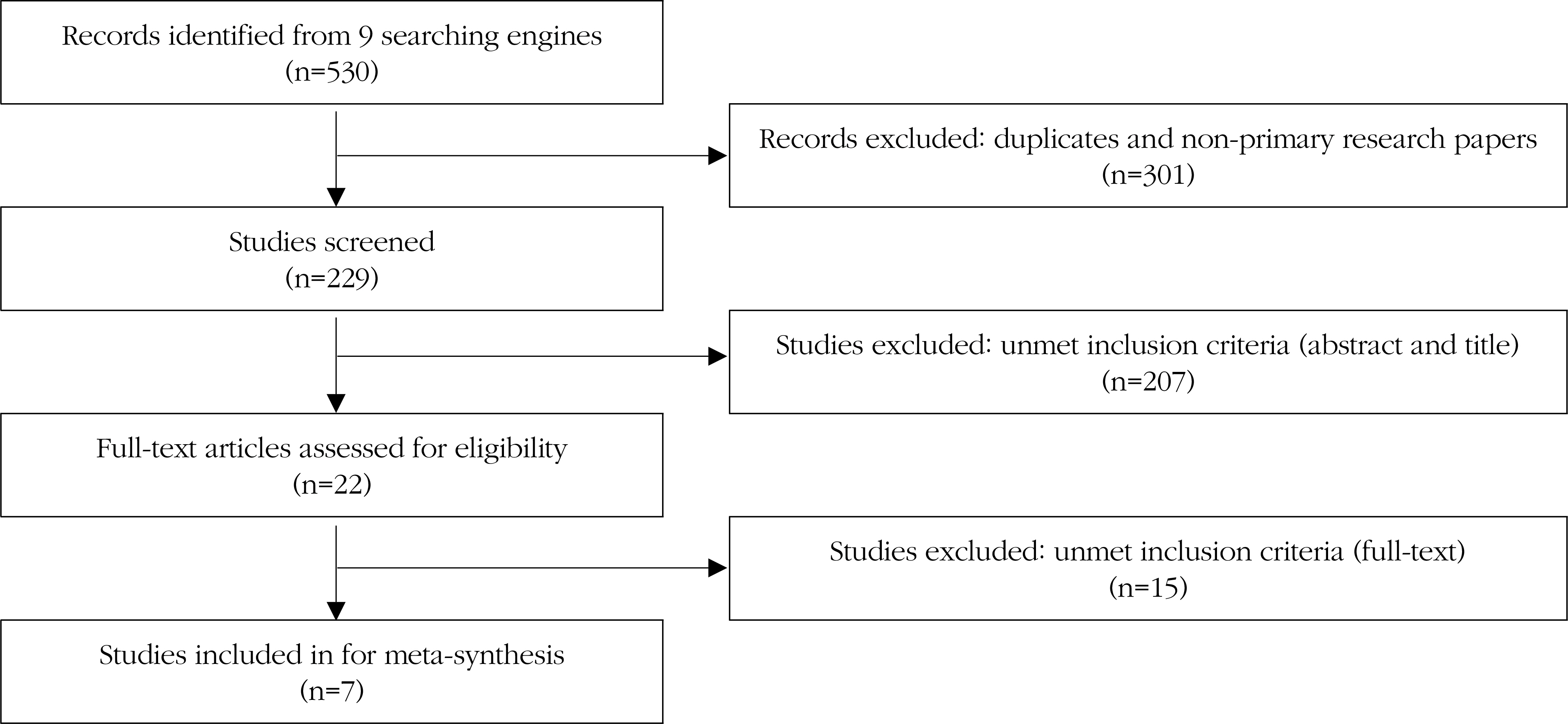1Chonnam National University Hospital, Gwangju
2Dream CIS, Seoul
3College of Nursing, Chonnam National University, Gwangju, Korea
Copyright © 2016 Korean Society of Adult Nursing
This is an Open Access article distributed under the terms of the Creative Commons Attribution Non-Commercial License (http://creativecommons.org/licenses/by-nc/3.0) which permits unrestricted non-commercial use, distribution, and reproduction in any medium, provided the original work is properly cited.
| “Lung cancer” (MeSH) | ||
| OR | ||
| Lung cancer | ||
| OR | ||
| Pulmonary cancer | “Stigma”: (MeSH) | |
| OR | OR | |
| Lung tumo?r | AND | Stigma∗ |
| OR | ||
| Pulmonary tumo?r | ||
| OR | ||
| Lung carcinoma | ||
| OR | ||
| Pulmonary carcinoma |


Searching Terms AND “Stigma” (MeSH)
| “Lung cancer” (MeSH) | ||
| OR | ||
| Lung cancer | ||
| OR | ||
| Pulmonary cancer | “Stigma”: (MeSH) | |
| OR | OR | |
| Lung tumo?r | AND | Stigma∗ |
| OR | ||
| Pulmonary tumo?r | ||
| OR | ||
| Lung carcinoma | ||
| OR | ||
| Pulmonary carcinoma |
Summary of the Included Studies
| Author (year) | Title | Nation | Method | Analysis method | Participants | Findings |
|---|---|---|---|---|---|---|
| Brown & Cataldo (2013) | Explorations of lung cancer stigma for female long-term survivors | USA | One-on-one and group interview | Gee's discourse analysis methodology, Fairclough's critical discourse theory, integrates thematic analysis, linguistic analysis, discourse analysis and critical discourse analysis | N=8 | Unvoiced precursors-tobacco industry and addiction influence |
| ․ Perception of LCS-diagnosis and interaction with healthcare providers | ||||||
| ․ Perception of stigma-shifting entities | ||||||
| ․ Responses to stigma-information control, advocacy | ||||||
| ․ Conflicting responses to stigma-simultaneous rejection and assumption of stigma | ||||||
| Chapple et al (2004) | Stigma, shame, and blame experienced by patients with lung cancer qualitative study | United Kingdom | Narrative interview | Not mentioned | N=45 | ․ Patient's experience and fear of stigma |
| ․ Resistance to blame and stigmatization | ||||||
| ․ Fear about lack of access to medical care | ||||||
| Hamann et al (2014) | Stigma among patients with lung cancer: A patient-reported measurement model | USA | Semi-structured interviews and focus groups | d Thematic analysis | ․ Interview group (n=42) | ․ Perceived/felt stigma |
| ․ Internalized stigma: self-blame, guilt, shame, anger, regret | ||||||
| ․ Five focus groups (n=23) | ․ Consequences | |||||
| Lehto (2014) | Patient views on smoking, lung cancer, and stigma: A focus group perspective | USA | A focus group | Thematic analysis | ․ Four focus groups (n=11) | ․ Societal attitudes |
| ․ Institutional practices and experiences | ||||||
| ․ Negative thoughts and emotions | ||||||
| ․ Actual stigmatization experiences | ||||||
| ․ Smoking cessation: personal choice versus addiction | ||||||
| ․ Causal attributions | ||||||
| Rowland et al (2014) | Quality of life, support and smoking in advanced lung cancer patients: a qualitative study | United Kingdom | Semi-structured interviews | Interpretative phenomenological analysis | N=9 | ․ Effects of illness on quality of life ․ Family support ․ Coping strategies ․ Medical support ․ Smoking |
| Scott et al (2015) | Stigma as a barrier to diagnosis of lung cancer: patient and general practitioner perspectives | Australia | Semi-structured in-depth interview | Thematic analysis | N=20 | ․ Experience of blame and stigma |
| ․ Patient (n=10), GP (n=10) | ․ GPs preconceptions of lung cancer risk | |||||
| ․ Anti-smoking messaging | ||||||
| Tod et al (2008) | Diagnostic delay in lung cancer | United Kingdom | Semi-structured individual interviews | Framework analysis | N=20 | ․ Symptom experience |
| ․ Knowledge | ||||||
| ․ Fear | ||||||
| ․ Blame and stigma | ||||||
| ․ Culture |
Quality Appraisal Tool (COREQ)
| Item | a1 | a2 | a3 | a4 | a5 | a6 | a7 |
|---|---|---|---|---|---|---|---|
| Domain 1: Research team and reflexivity | |||||||
| 1. Interviewer/Facilitator Which author/s conducted the interview or focus group? | nc | ✓ | nc | ✓ | nc | nc | ✓ |
| 2. Credentials What were the researcher's credentials? | ✓ | ✓ | nc | ✓ | ✓ | X | ✓ |
| 3. Occupations What was their occupation at the time of the study? | ✓ | ✓ | ✓ | ✓ | nc | ✓ | ✓ |
| 4. Gender Was the researcher male or female? | nc | nc | nc | nc | nc | nc | nc |
| 5. Experience and training What experience or training did the researcher have? | nc | nc | ✓ | ✓ | X | nc | X |
| 6. Relationship established Was a relationship established prior to study commencement? | X | X | ✓ | ✓ | X | X | X |
| 7. Participant knowledge of interviewer What did the participants know about the researcher? | X | X | ✓ | ✓ | X | X | X |
| 8. Interviewer characteristics What characteristics were reported about the interviewer/facilitator? | X | ✓ | ✓ | ✓ | X | nc | X |
| Domain 2: Study design | |||||||
| 9. Methodological orientation and Theory What methodological orientation was stated to underpin the study? | ✓ | X | ✓ | v | ✓ | ✓ | ✓ |
| 10. Sampling How were participants selected? | ✓ | ✓ | ✓ | ✓ | ✓ | ✓ | ✓ |
| 11. Method of approach How were participants approached? | ✓ | ✓ | ✓ | ✓ | ✓ | ✓ | ✓ |
| 12. Sample size How many participants were in study? | ✓ | ✓ | ✓ | ✓ | ✓ | ✓ | ✓ |
| 13. Non-participation How many people refused to participate or dropped out? Reasons? | X | X | ✓ | ✓ | ✓ | X | X |
| 14. Setting of data collection Where was the data collected? | nc | ✓ | ✓ | ✓ | ✓ | X | ✓ |
| 15. Presence of non-participants Was anyone else present besides the participants and researchers? | X | X | ✓ | X | X | X | ✓ |
| 16. Description of sample What are the important characteristics of the sample? | ✓ | ✓ | ✓ | ✓ | ✓ | nc | ✓ |
| 17. Interview guide Were questions, prompts, guides provided by the authors? Was it pilot tested? | ✓ | X | ✓ | X | ✓ | X | X |
| 18. Repeat Interviews Were repeat interviews carried out? If yes, how many? | X | X | X | X | X | X | X |
| 19. Audio/visual recording Did the research use audio or visual recording to collect the data? | ✓ | ✓ | ✓ | ✓ | ✓ | ✓ | ✓ |
| 20. Field notes Were field notes made during and/or after the interview or focus group? | X | X | X | X | X | X | ✓ |
| 21. Duration What was the duration of the interviews or focus group? | ✓ | ✓ | X | nc | ✓ | X | ✓ |
| 22. Data saturation Was data saturation discussed? | X | ✓ | ✓ | X | ✓ | X | X |
| 23. Transcripts returned Were transcripts returned to participants for comment and/or correction? | X | ✓ | X | X | X | X | X |
| Domain 3: Analysis and findings | |||||||
| 24. Number of data coders How many data coders coded the data? | X | ✓ | ✓ | ✓ | ✓ | X | ✓ |
| 25. Description of the coding tree Did authors provide a description of the coding tree? | X | X | nc | X | ✓ | X | X |
| 26. Derivation of themes Were themes identified in advance or derived from the data? | ✓ | ✓ | ✓ | ✓ | ✓ | ✓ | ✓ |
| 27. Software What software, if applicable, was used to manage the data? | X | ✓ | ✓ | X | X | ✓ | ✓ |
| 28. Participant checking Did participants provide feedback on the findings? | X | X | ✓ | X | X | X | X |
| 29. Quotations presented Were participant quotations presented to illustrate the themes/findings? | ✓ | ✓ | ✓ | ✓ | ✓ | ✓ | ✓ |
| 30. Data and findings consistent Was there consistency between the data presented and the findings? | ✓ | ✓ | ✓ | ✓ | ✓ | ✓ | ✓ |
| 31. Clarity of major themes Were major themes clearly presented in the findings? | ✓ | ✓ | ✓ | ✓ | ✓ | ✓ | ✓ |
| 32. Clarity of minor themes Is there a description of diverse cases or discussion of minor themes? | nc | nc | ✓ | ✓ | ✓ | nc | nc |
Key: ✓=Information was provided and described; X=Information was not provided; nc=Information was not clear or sufficient.
Meta-aggregation Process
| Findings (Extraction) ➡ | Categories (Categorization) ➡ | Sub-themes (Categorization) ➡ | Synthesis (Synthesization) |
|---|---|---|---|
| 53 findings from 7 papers | Perceived stigma by public Perceived stigma by family and friends Perceived stigma by health care providers | Experiencing some distance from the surrounded world | Experiencing external and internal distances, which mandates authentic and consistent supports |
| Blame, guilt, shame, and frustration Regret, anger, and fear Shifting of identities Social isolation and loneliness | Experiencing self-made distance between the disease and oneself The disease experience causes social isolation and loneliness | ||
| Lack of supportive care | There is lack of supportive care for myself |
Key: ✓=Information was provided and described; X=Information was not provided; nc=Information was not clear or sufficient.

